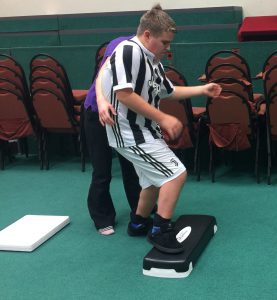Are Conductive Education services just for children?!
Well in a nutshell – no!
Many people ask if Conductive Education services are just for children…
 At CEBristol we work primarily with children though we work with teenagers and adults with Cerebral Palsy too. CE however is beneficial to anyone with a Neurological Movement disorder of which Cerebral Palsy is just a small section – other Neurological Movement disorders such as Parkinsons, Stroke and MS benefit greatly from the Conductive Education approach.
At CEBristol we work primarily with children though we work with teenagers and adults with Cerebral Palsy too. CE however is beneficial to anyone with a Neurological Movement disorder of which Cerebral Palsy is just a small section – other Neurological Movement disorders such as Parkinsons, Stroke and MS benefit greatly from the Conductive Education approach.
Many of our children start with us in the parent and child groups and so this is their first experience of CE. CE however is for all ages and we believe learning is lifelong and everyone has the capacity to learn and grow. Many of our older children / teenagers have been with us (or at other CE settings) since parent and child services but some children and adults find us later in life.
How do sessions differ then for different ages? [Don’t worry we don’t sing in the older groups! Luckily for them!]
Well firstly lets look at what is the same… What are the main principles of CE?
- The Conductor and Conductive team
- The group [The majority of our services run as a group and this is a big part of our motivation and facilitation]
- The task series [the series of tasks and activites in each programme which are set up to meet the groups aims and the aims of each individual within it]
- The daily routine [We often talk about how we work on a range of everyday skills throughout our sessions – these are built into the timetable of our session – our daily routine – transferring, snack time, dressing and undressing skills are important activities and by incoroprating them into the routine of the session in a meaningful way there is purpose to the activity and therefore motivation and learning]
- Facilitation! [What do we really mean by facilitation? Support? Help? Almost – depending on your definition of the previous words but not quite… and so much more! Maybe I will write a post all about facilitation! But for now lets just say…… Facilitation is giving the correct level of input at any given time- enough for success but only just enough so learning can occur! Facilitation can be many things in many ways and is always changing – the most obvious is manual facilition – physically supporting someone to succeed – not doing it for them – but enabling them to do it for themselves while gradually reducing this support as learning occurs……. then there are all the less obvious facilitation methods – verbal instruction and encouragement, group encouragement, watching peers and how they succeed at tasks and giving the correct rhythm……]
- Conductive Observation – yes we really do have eyes in the back of our heads! Conductive Observation is obviously seeing all! Whether we are working with a child ourselves or not we always know how they are attemping / achieving a task! Conductive Observation is not just observation and our reaction in the moment [adjusting the task, the facilitation….] but observation over time and also our observation of them within the group dynamic.
- The aim of CE remains the same for all ages – to increase skills and independence through the development of a confident, active, problem solving personality. [See the “What are we really trying to achieve” post for more on the aim of CE!]
So what is different?
Sessions are age and interest appropriate – songs and cause and effect / role play toys in the younger groups – games and challenges for the older children ./ teenagers – tasks linked directly to aims set by the teenager / adult themselves in older groups. As children grow into teenagers and teenagers into adults different difficutlies arrise, different situations arrise and so different aims arrise – its from these which we base our sessions and tasks around.
The rhythm of the session is also determined by muscle tone – a slower rhythm for those with higher tone. In general this is similar across children and adults – a child with spastic Cerebral Palsy and an adult who has had a stroke will both have higher tone and therefore require a slow smooth rhythm [exact rhythm determined by group participants] to allow them to use their full range of movements. For participants with Parkinsons, Dyspraxia or Athetoid cerebral Palsy the rhythm will be much faster. Age and understanding will determine how the rhythm is given… song, repeating the task or by giving a count.

Interesting read, Natalie. Something to think about. Thanks for posting.
One huge difference that comes to mind is the different role of parents.